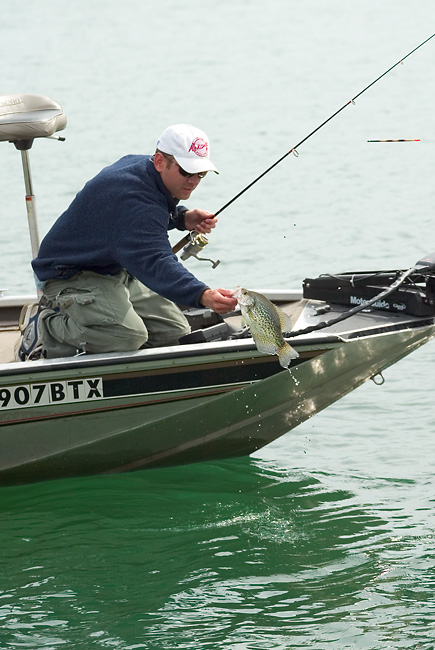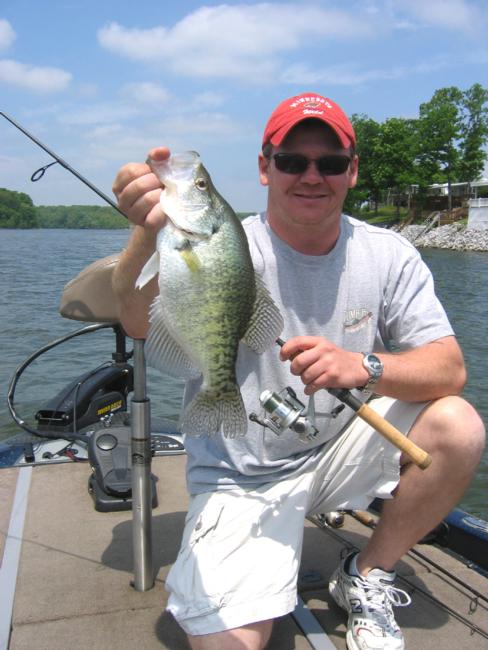Advanced winter crappie strategies
When traditional fishing tactics aren’t working on winter crappies, it’s time to “think outside the box”

————————————–
Editor’s note: This article originally appeared in the January-February 2006 issue of FLW Outdoors Magazine.
————————————–
Winter fishing can unnerve the most determined crappie angler. Our favorite panfish are often tight-lipped this time of year, and standard fishing tactics sometimes won’t catch them. You can hook cold-water slabs, however, if you’re willing to think “outside of the box” and try advanced crappie-fishing strategies such as these:
Think “new places”
Could there be a better place than a deep-water brush pile to find winter crappies? Most anglers think not. But when targeting trophy crappies, you may want to avoid brush piles entirely. Unlike small crappies, which find safety from predators in brush piles, crappies weighing 2 pounds or more aren’t on the menu of many meat-eaters. Their own appetite is substantial, however, so they follow schools of shad, feasting on the high-protein baitfish to fuel their internal furnaces.
“Lots of brush piles placed in an area may actually keep big crappies away,” said Oklahoma City crappie guide Todd Huckabee. “The schools of shad big crappies feed on prefer open water without obstructions that block their movements. If brush piles are in the area, the fish must go around them. They don’t like this, so they avoid these areas.
“You’ll catch more and bigger crappies if you fish near underwater ledges, riprap banks or even the bottom where shad are schooling.”
To do this, you must first determine the depth of the shad. Turn on your depth finder and watch for the dark horizontal band that indicates a school below. The corresponding depth is the depth you should fish.
Use a 12-foot jigging pole and tie two crappie jigs 18 inches apart at the end of the line. If shad are 10 feet deep, position the jigs so they’ll be at 10 feet during a slow troll. Maintain a speed that keeps your line mostly perpendicular to the water’s surface. Slightly lift and drop the rig as you move.
Watch your sonar, and keep your rig working in and around the shad school. When you reach the edge of the school, turn and troll through again. Typically, you’ll catch two or more crappies on each pass. And typically, these will be “barn doors” – slab crappies weighing 2 pounds or more.
Brainstorm on other roads-less-traveled to discover new crappie hotspots. The best places often are those you’ve never considered.
Think “new baits”
Sometimes finicky winter crappies refuse to bite the two baits anglers use most – jigs and minnows. What now?
“Most crappie anglers use jigs or minnows and nothing else,” said Lewis Peeler, an ardent crappie fisherman from Wynne, Ark. “I’ve seen times, though, when other baits worked best. On some lakes I’ve fished in Louisiana, we caught more crappies on freshwater shrimp. Crappies in ponds near my home seem to hit small spinners better than jigs or minnows. On certain lakes, I catch most crappies using small shad-imitation crankbaits.
“The key is versatility,” he continued. “If one bait or lure doesn’t work, be prepared to try something different.”
One unconventional winter-crappie catcher is a 4 1/2-inch Smithwick Rattlin’ Rogue. Rig the lure Carolina style, with a 1/8- to 1/4-ounce tungsten weight above a barrel swivel on your line, and a 3- to 4-foot leader from swivel to lure. Crawl the lure across the bottom. Crappies unwilling to dart out after smaller prey often find it hard to resist this sizeable entree.
 When water is cold and crappies are deep, bladebaits such as the Cordell Gay Blade, Heddon Sonar and Silver Buddy also can be hot, despite the fact that few anglers ever try them. Snapped upward, a bladebait creates a pulsating vibration that mimics an injured or escaping baitfish. You can vertically jig a bladebait to create a subtle swimming and fluttering motion, effective at attracting skittish, light-biting crappies; or you can occasionally rip it on a steady retrieve to produce a dynamic, erratic action that might interest a slab in need of a wake-up call.
When water is cold and crappies are deep, bladebaits such as the Cordell Gay Blade, Heddon Sonar and Silver Buddy also can be hot, despite the fact that few anglers ever try them. Snapped upward, a bladebait creates a pulsating vibration that mimics an injured or escaping baitfish. You can vertically jig a bladebait to create a subtle swimming and fluttering motion, effective at attracting skittish, light-biting crappies; or you can occasionally rip it on a steady retrieve to produce a dynamic, erratic action that might interest a slab in need of a wake-up call.
Other lures outside the norm may also entice big winter crappies, including small versions of bass spinnerbaits, tailspinners like Mann’s Little George, soft-plastic grubs and shad bodies. The key is to experiment when usual enticements don’t work.
Think “new methods”
A new presentation sometimes is the best means to arouse the feeding instincts of persnickety winter crappies. Consider jigs, for example. By the time winter is in full swing, the baitfish crappies eat are larger on average than baitfish at other times of year. This being the case, one would suspect that jigs with a larger silhouette would entice more winter crappies. This is true if the jigs are configured to allow for a very slow presentation. A crappie’s metabolism plunges when the water temperature falls, and the fish often refuse to chase lures, even for short distances. Thus, the jigs used to entice them often must be presented very slowly. The lure may have to enter the fish’s strike zone and remain there for some time for the best results.
This explains why many anglers downsize their jigs in winter, even though most forage fish are quite large. The most elementary way to slow a lure’s descent is to reduce its size. Micro-jigs of 1/64 ounce and smaller drop through the water column at the agonizingly slow rate winter crappie prefer. Heavier jigs fall faster, often descending too quickly for lethargic crappie to strike. It would seem to make sense, then, that smaller lures would work better.
That might be true if downsizing your jig was the only way to slow it down. But it’s not. Another simple method is to use heavier line. Heavier line causes more resistance in the water, forcing jigs to fall more slowly. In clear water, where line-shy fish are a concern, an easy solution is adding a foot or two of lighter leader between the main line and the jig. Another effective approach for reducing the fall rate is using a larger jig body (one bigger than what normally would be matched with a given jighead size) to create increased water resistance.
A bobber presents yet another means for fishing a jig slowly. A float rig allows the jig to be suspended, which means it can be worked at almost any pace, including a dead stop. If crappies are holding deeper than 6 feet, as they tend to do in winter, casting with a traditional float might be impractical. A slip cork, however, serves the same function and can be rigged with a bobber stop, so it suspends your jig at the correct depth.
Knowing these things, you now can do a better job matching your jig to the size of most baitfish being eaten by cold-water crappies. If crappies are stuffed with 2-inch shad, you can present a 2-inch, wide-bodied jig beneath a float and work it very slowly at the depth crappies are suspended. When crappie forage consists primarily of large minnows, you can slow the presentation of properly matched jigs by using 15- or even 20-pound-test line, with an added leader if necessary, or by using a 1/32-ounce jighead with a jig body more often used with a 1/16-ounce jighead. The options are countless.
Remember, a successful winter crappie angler must be flexible and innovative – ready to try something new or different when “regular” fishing tactics won’t produce. Don’t get stuck in a rut. Innovation often leads to success.
Think “new waters”
Most anglers confine their winter crappie fishing to lakes and reservoirs. But these aren’t the only places to enjoy cold-weather slab action.
The tailwaters below dams on big lowland streams often serve up good fishing. As the water starts warming near winter’s end, river crappies move upstream searching for bedding sites. If they encounter a dam during this seasonal migration, crappies will mill around the tailwater for a while, holding in areas with moderate current. Try a jig/minnow combo for bait, and focus your efforts on edge areas, or seams, where faster current meets slack water – around rock wing dams, shoreline riprap, the outer edges of willow thickets, chutes connecting backwaters to the main river and similar locations.
Farm ponds also provide possibilities for winter anglers. First, be sure the pond contains crappies; many don’t. If it does, and the owner grants permission to fish, you’re in business. Head to the levee that impounds the water. Big slabs are frequently taken by casting to woody cover here. A great lure in this situation is a large, beetle-type safety-pin spinner, but carry a variety of lures, and keep changing until you determine what is most productive.